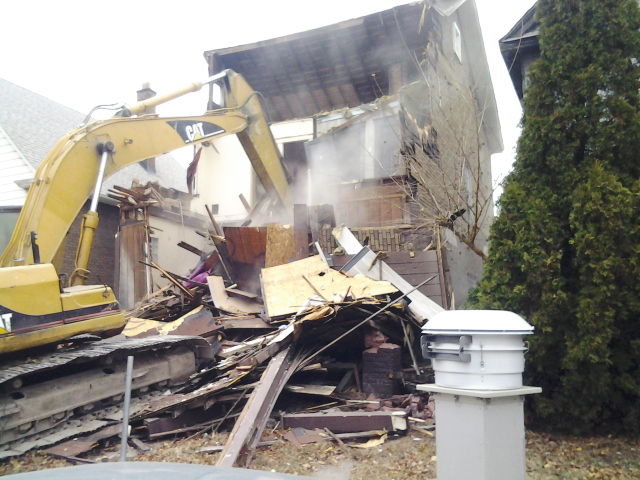

The Partial Deconstruction Pilot Project was staged to measure the economic and environmental impacts of building removal within neighborhoods where people and blight exist side by side.
We purchased ten houses through the local Wayne County Tax Foreclosure Auction in order to remove them from the neighborhood using demolition and deconstruction tactics. Through an unlikely collaboration, we deployed geologists, demolition contractors, futurists, deconstruction work crews and time / motion studies in our quest to understand and measure the building removal process.
At the outset we understood the potential for the application of our results at scale here in Detroit, given the large volume of building removal activities planned locally.
This project focused on ten buildings in the Springwells neighborhood of Detroit.

Ten Houses, One Neighborhood
We acquired ten houses all located in one Detroit neighborhood for $550 each. We selected these structures because they were relatively close to each other, all located within one neighborhood and none on the same block.
We worked with two local organizations (Bridging Communities and Urban Neighborhood Initiatives) to inform our outreach and engagement, including bilingual neighbor and neighborhood notifications.
At the time of the study, the houses had experienced similar levels of degradation. Scrappers have already stripped them of interior pipes, copper wiring, appliances, circuit boxes and metal fixtures. Each has some degree of structural damage due to water, fire, and the cumulative impact of prolonged neglect and disrepair.
A time lapse walk-through of 10 vacant houses purchased at the Wayne County Tax Foreclosure auction in the Springwells neighborhood of Detroit.
The How of Building Removal
Deconstruction is a process by which valuable building materials are carefully removed from unused structures so that they may be diverted from landfills, and made available for repurposing. Proponents see it as an alternative to traditional demolition, with concrete environmental and employment benefits. Several studies have established that the deconstruction of an obsolete but otherwise healthy structure is an economically viable alternative to traditional demolition. Yet no studies exist that focus on the deconstruction of physically compromised structures.
In the autumn of 2013, we embarked on this project to investigate the viability of deconstruction techniques when applied to structures damaged by fire, water, and neglect. Such conditions are common among single-family houses caught in the tax foreclosure cycle in Southeast Michigan. In particular, we aimed to understand whether partial deconstruction techniques might prove useful within broader efforts to manage Detroit’s large and growing inventory of vacant, open and dangerous buildings.









Air quality regulations do not currently exist for residential demolition.

At present in the United States, lead testing and abatement are not required as part of the standard residential demolition process.
This needs to change.
Whether building removal is motivated by the demands of a strong real estate market or by efforts to stabilize vacancy, people living nearby are vulnerable to the hazards of demolition.
Learn more
The Partial Deconstruction Pilot Project focused on ten buildings in the Springwells neighborhood of Detroit that together represented conditions present in Detroit’s unoccupied, single-family homes. This project shows that partial deconstruction is indeed a viable solution to managing obsolete and vacant structures in neighborhoods with moderate levels of vacancy – neighborhoods where people and blight exist side by side
learn about the team behind the work
Learn more about the tri-sector group of experts, practitioners and designers convened to collaborate around this project.
connect with additional resources
These free tools will help you climb the learning curve and take wise action in your next building removal initiative.
Learn about our impact
Discover some of the outcomes of this unlikely collaboration and see how the recommendations have come to life.


